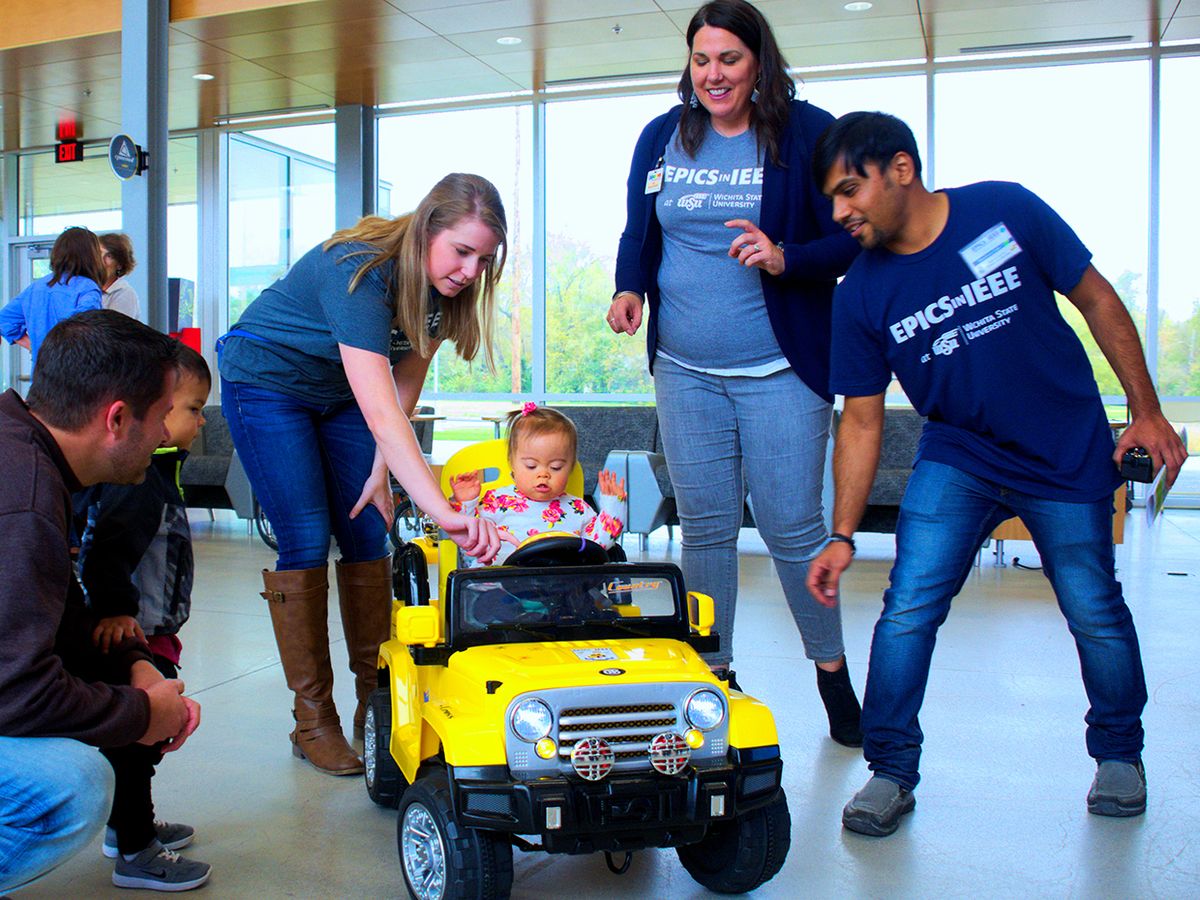THE INSTITUTEThe Epsilon Xi Chapter of IEEE Eta Kappa Nu (IEEE-HKN) at Wichita State University, in Kansas, set out last March to build 17 customized battery-powered toy cars for local children with special needs. Thanks to a US $10,000 grant from Engineering Projects in Community Service (EPICS) in IEEE, the honor society students are only four cars away from reaching their goal.
EPICS in IEEE is funded by donations to the IEEE Foundation, the organization's philanthropic arm. The program has awarded nearly $525,000 in grants to more than 100 projects to date.
The IEEE-HKN members worked 32 other students as well as 53 high school students and 18 IEEE volunteers to develop low-cost ride-on cars that are adapted to meet the children’s needs. The cars are designed to help develop the kids’ cognitive and social skills.
The students teamed up with Rainbows United—a nonprofit in Wichita that helps children with disabilities—to distribute the cars.
There are few commercially available devices to help children with mobility issues move around on their own. Manual wheelchairs can be difficult to operate depending on the disability. Ride-on toy cars are one solution, but expensive. Off-the-shelf versions sold at national chain stores cost around $240.
There are few commercially available devices to help children with mobility issues move around on their own. Manual wheelchairs can be difficult to operate depending on the disability. In this project, students used off-the-shelf ride-on cars that are sold in stores for $240 and modified them for children with disabilities. The cars, which are offered to families for free, provide children independent mobility that positively impacts their motor, cognitive, language and social-emotional development—particularly for children younger than 5.
GETTING FUNDING
The project was initiated after some of the IEEE-HKN members began to work on the university’s existing Go Baby Go initiative, according to Anton Hettiarachchige Don, an IEEE student member who serves as the project’s build manager. “The goal was to bring more engineering experience to the project and to produce more complex builds to support children with greater needs,” he says.
Go Baby Go is a program that began at the University of Delaware, Newark, where students customized ride-on cars for children. More than 75 spin-off groups at universities around the world have built thousands of cars for kids with special needs.
The Epsilon Xi Chapter students learned about EPICS in IEEE during the 2016 IEEE-HKN Student Leadership Conference, held in Ann Arbor, Mich. They decided to submit a grant proposal to customize about 17 cars in 12 months.
“What initially excited us about the project was the opportunity for innovative engineering,” Hettiarachchige Don says. “We were interested to see what sensors we could incorporate into the cars, how intelligent of a control system we could implement, and so on.” The group created ultrasonic collision-avoidance systems, developed Android apps that could control the car wirelessly, and added a host of other features.
“We hope to continue this effort into the new year with further funding,” he says.
CHANGING LIVES
The group began to get positive feedback from parents, who reported they and their children were happy with the cars.
“During the design process, we gave little thought to how the cars would affect people personally,” Hettiarachchige Don says. “That all changed when we delivered our first car. We realized that while this was just an exciting project for us, for the families these cars were life-changers.”
Parents reported their children were riding around the neighborhood on their own, exploring their surroundings, and interacting with others.
The students recently received a letter from one of the mothers, who wrote that her daughter, who is deaf, points to the car and signs please nearly every time she sees it. “Since getting the car, Emily has experienced a leap in her motor and cognitive skills,” the mother wrote. “She’s had more interest in figuring out how to stand and take steps, and has added more words to her sign-language vocabulary.”
Hettiarachchige Don says one of the physiotherapists the team works with reported how touching it was when one of the moms teared up while telling her how the neighborhood children began interacting with her son when he drove his customized car. Another parent said she was excited to see the social and cognitive advancements in her daughter, who now has new opportunities to explore her environment and play with her sister.
“What drives us now is no longer just the opportunity to advance our engineering skills,” Hettiarachchige Don says. “It’s the feedback we continue to receive about how our work is changing the lives of these families and further solidifying our belief that our engineering education can be used for great community service.”
